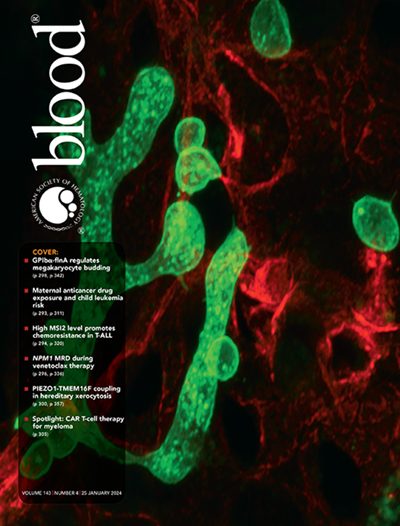TCA循环模式切换决定了套细胞淋巴瘤中耐匹托鲁替尼持久性细胞的命运。
IF 23.1
1区 医学
Q1 HEMATOLOGY
引用次数: 0
摘要
布鲁顿酪氨酸激酶抑制剂(BTKi)和细胞疗法已成功用于治疗套细胞淋巴瘤(MCL);然而,治疗抵抗不可避免地出现。癌细胞可以通过短暂的耐药持久性(DTP)状态逐渐产生稳定的耐药性。使DTP细胞可逆地适应治疗并进化获得异质性的机制仍然知之甚少,并且表征MCL中的DTP细胞仍然对临床翻译构成挑战。在这里,我们使用pirtobrutinib(一种最近获得fda批准的非共价BTKi),通过呈现一种具有可逆命运转变的独特的扩大细胞(巨细胞)群,发现了pirtobrutinib耐受持久性细胞,这些细胞表现出形态变异。在治疗过程中,巨细胞进入非增殖、去分化状态,依赖于激活的胞质三羧酸(TCA)循环,结合苹果酸-天冬氨酸穿梭进行生物合成。去除药物后,TCA循环转变为氧化分解代谢,促进巨细胞分化为正常大小的细胞。在整个转变过程中,乙酰辅酶a通过微调干性来调节细胞命运。我们的双相模型表明,代谢开关控制着MCL中DTP细胞的表型可塑性,导致DTP细胞在不同的发育状态下动态存在,以响应全身治疗。在巨细胞分化之前靶向它们是克服MCL治疗耐药的一个有希望的策略。本文章由计算机程序翻译,如有差异,请以英文原文为准。
TCA cycle mode switch determines the fate of pirtobrutinib-tolerant persister cells in mantle cell lymphoma.
Bruton's tyrosine kinase inhibitors (BTKi) and cell therapy have successfully been used to treat mantle cell lymphoma (MCL); however, therapy resistance inevitably emerges. Cancer cells can progressively develop stable resistance by traversing through a transient drug-tolerant persister (DTP) state. The mechanisms enabling DTP cells to reversibly adapt to therapies and evolve to acquire heterogeneity remain poorly understood, and characterizing DTP cells in MCL continues to pose a challenge for clinic translation. Here using pirtobrutinib, a recently FDA-approved non-covalent BTKi, we identified pirtobrutinib-tolerant persister cells exhibiting morphological variability by presenting a unique population of enlarged cells (Giant cells) with reversible fate transitions. During treatment, Giant cells enter a non-proliferative, dedifferentiated state, addicted to an activated cytosolic tricarboxylic acid (TCA) cycle coupled with the malate-aspartate shuttle to engage in biosynthesis. Upon drug removal, the TCA cycle shifts to oxidative catabolism, promoting Giant cells to differentiate into regular-sized cells. Throughout the transition, acetyl-CoA modulates cell fate by fine-tuning stemness. Our biphasic model demonstrates that the metabolic switch governs the phenotypic plasticity of DTP cells in MCL, resulting a dynamic presence of DTP cells across various developmental states in response to systemic therapies. Targeting Giant cells prior to their differentiation offers a promising strategy to overcoming therapy resistance in MCL.
求助全文
通过发布文献求助,成功后即可免费获取论文全文。
去求助
来源期刊

Blood
医学-血液学
CiteScore
23.60
自引率
3.90%
发文量
955
审稿时长
1 months
期刊介绍:
Blood, the official journal of the American Society of Hematology, published online and in print, provides an international forum for the publication of original articles describing basic laboratory, translational, and clinical investigations in hematology. Primary research articles will be published under the following scientific categories: Clinical Trials and Observations; Gene Therapy; Hematopoiesis and Stem Cells; Immunobiology and Immunotherapy scope; Myeloid Neoplasia; Lymphoid Neoplasia; Phagocytes, Granulocytes and Myelopoiesis; Platelets and Thrombopoiesis; Red Cells, Iron and Erythropoiesis; Thrombosis and Hemostasis; Transfusion Medicine; Transplantation; and Vascular Biology. Papers can be listed under more than one category as appropriate.
 求助内容:
求助内容: 应助结果提醒方式:
应助结果提醒方式:


